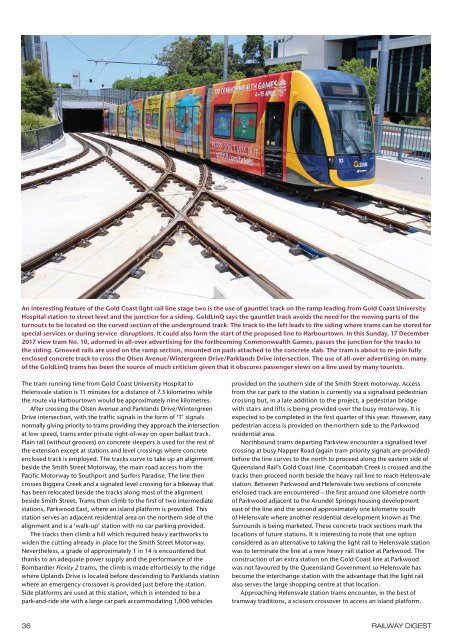Railway_Digest__February_2018
Create successful ePaper yourself
Turn your PDF publications into a flip-book with our unique Google optimized e-Paper software.
An interesting feature of the Gold Coast light rail line stage two is the use of gauntlet track on the ramp leading from Gold Coast University<br />
Hospital station to street level and the junction for a siding. GoldLinQ says the gauntlet track avoids the need for the moving parts of the<br />
turnouts to be located on the curved section of the underground track. The track to the left leads to the siding where trams can be stored for<br />
special services or during service disruptions. It could also form the start of the proposed line to Harbourtown. In this Sunday, 17 December<br />
2017 view tram No. 10, adorned in all-over advertising for the forthcoming Commonwealth Games, passes the junction for the tracks to<br />
the siding. Grooved rails are used on the ramp section, mounted on pads attached to the concrete slab. The tram is about to re-join fully<br />
enclosed concrete track to cross the Olsen Avenue/Wintergreen Drive/Parklands Drive intersection. The use of all-over advertising on many<br />
of the GoldLinQ trams has been the source of much criticism given that it obscures passenger views on a line used by many tourists.<br />
The tram running time from Gold Coast University Hospital to<br />
Helensvale station is 11 minutes for a distance of 7.3 kilometres while<br />
the route via Harbourtown would be approximately nine kilometres.<br />
After crossing the Olsen Avenue and Parklands Drive/Wintergreen<br />
Drive intersection, with the traffic signals in the form of ‘T’ signals<br />
normally giving priority to trams providing they approach the intersection<br />
at low speed, trams enter private right-of-way on open ballast track.<br />
Plain rail (without grooves) on concrete sleepers is used for the rest of<br />
the extension except at stations and level crossings where concrete<br />
enclosed track is employed. The tracks curve to take up an alignment<br />
beside the Smith Street Motorway, the main road access from the<br />
Pacific Motorway to Southport and Surfers Paradise. The line then<br />
crosses Biggera Creek and a signaled level crossing for a bikeway that<br />
has been relocated beside the tracks along most of the alignment<br />
beside Smith Street. Trams then climb to the first of two intermediate<br />
stations, Parkwood East, where an island platform is provided. This<br />
station serves an adjacent residential area on the northern side of the<br />
alignment and is a ‘walk-up’ station with no car parking provided.<br />
The tracks then climb a hill which required heavy earthworks to<br />
widen the cutting already in place for the Smith Street Motorway.<br />
Nevertheless, a grade of approximately 1 in 14 is encountered but<br />
thanks to an adequate power supply and the performance of the<br />
Bombardier Flexity 2 trams, the climb is made effortlessly to the ridge<br />
where Uplands Drive is located before descending to Parklands station<br />
where an emergency crossover is provided just before the station.<br />
Side platforms are used at this station, which is intended to be a<br />
park-and-ride site with a large car park accommodating 1,000 vehicles<br />
provided on the southern side of the Smith Street motorway. Access<br />
from the car park to the station is currently via a signalised pedestrian<br />
crossing but, in a late addition to the project, a pedestrian bridge<br />
with stairs and lifts is being provided over the busy motorway. It is<br />
expected to be completed in the first quarter of this year. However, easy<br />
pedestrian access is provided on the northern side to the Parkwood<br />
residential area.<br />
Northbound trams departing Parkview encounter a signalised level<br />
crossing at busy Napper Road (again tram priority signals are provided)<br />
before the line curves to the north to proceed along the eastern side of<br />
Queensland Rail’s Gold Coast line. Coombabah Creek is crossed and the<br />
tracks then proceed north beside the heavy rail line to reach Helensvale<br />
station. Between Parkwood and Helensvale two sections of concrete<br />
enclosed track are encountered – the first around one kilometre north<br />
of Parkwood adjacent to the Arundel Springs housing development<br />
east of the line and the second approximately one kilometre south<br />
of Helensvale where another residential development known as The<br />
Surrounds is being marketed. These concrete track sections mark the<br />
locations of future stations. It is interesting to note that one option<br />
considered as an alternative to taking the light rail to Helensvale station<br />
was to terminate the line at a new heavy rail station at Parkwood. The<br />
construction of an extra station on the Gold Coast line at Parkwood<br />
was not favoured by the Queensland Government so Helensvale has<br />
become the interchange station with the advantage that the light rail<br />
also serves the large shopping centre at that location.<br />
Approaching Helensvale station trams encounter, in the best of<br />
tramway traditions, a scissors crossover to access an island platform.<br />
36 RAILWAY DIGEST


